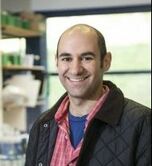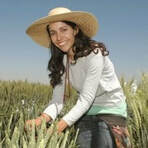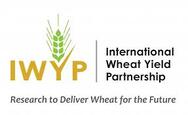IWYP:
Manipulating Stomatal Blue Light Response in Wheat to Improve Productivity
Research collaboration between University of Essex (Lead), John Innes Centre, University of Lancaster, CIMMYT.
Rationale: World demand for food is growing and it has been estimated that a 50% increase in yield will be required to meet the rising need due to the growing world population. This situation is further exacerbated by the predicted variation in climate. Photosynthesis is the process by which plants use the energy from the sun to convert carbon dioxide (CO2) from the atmosphere into carbohydrates and other chemical compounds, which are used for growth. In order for leaf photosynthesis to take place, CO2 must enter the leaf and does this through adjustable pores, called stomata. As CO2 enters, water is lost through these pores, which aids cooling of the leaf. Stomatal behaviour controls photosynthesis, water use and leaf temperature and these leaf pores are therefore an important, and unexploited, target for manipulation to improve crop productivity.
Stomata open in response to increasing light, and two different responses have been described according to the wavelength of light. The first is named the “red” light or mesophyll response, occurs at high light levels and is linked directly to the rates of photosynthesis. The second is the “specific blue” light response and saturates at light levels too low to drive photosynthesis, which leads to stomata being more open than needed to achieve maximum CO2 uptake for photosynthesis; therefore, the ratio of carbon gain to water loss, known as water use efficiency (WUE), is reduced. Reducing stomatal sensitivity to blue light has the potential to optimise the crop’s resource use, thereby maintaining photosynthetic rates while using water more efficiently. Decreasing water use will enable sustained photosynthetic rates through the grain filling period when water becomes limiting, thus enhancing overall photosynthetic potential of the crop throughout the cycle and increasing grain yield.
We will use a non-transgenic tilling approach to identify single mutations in a gene known to be essential in stomatal responses to blue light (BLUS1) in each of the wheat homoeologs (A, B and D) and use these to generate single, double and triple mutants in a variety of different backgrounds. Mutants generated will be phenotyped for gas-exchange, photosynthetic biochemistry and grain yield production in both controlled environment conditions and 2 different field environments.
From this work we will deliver non-transgenic wheat plants with improved photosynthetic capacity throughout the crop cycle combined with better water use, and maximized productivity under a range of environmental conditions. These results will feed into existing breeding pipelines and the outcomes of this research will be of benefit to developing countries, contributing to sustainability and resource use efficiency through the production of cultivars with varying stomatal conductance, leaf temperatures and water use efficiencies, which will be advantageous for maximal growth in a range of different agricultural environments.
Rationale: World demand for food is growing and it has been estimated that a 50% increase in yield will be required to meet the rising need due to the growing world population. This situation is further exacerbated by the predicted variation in climate. Photosynthesis is the process by which plants use the energy from the sun to convert carbon dioxide (CO2) from the atmosphere into carbohydrates and other chemical compounds, which are used for growth. In order for leaf photosynthesis to take place, CO2 must enter the leaf and does this through adjustable pores, called stomata. As CO2 enters, water is lost through these pores, which aids cooling of the leaf. Stomatal behaviour controls photosynthesis, water use and leaf temperature and these leaf pores are therefore an important, and unexploited, target for manipulation to improve crop productivity.
Stomata open in response to increasing light, and two different responses have been described according to the wavelength of light. The first is named the “red” light or mesophyll response, occurs at high light levels and is linked directly to the rates of photosynthesis. The second is the “specific blue” light response and saturates at light levels too low to drive photosynthesis, which leads to stomata being more open than needed to achieve maximum CO2 uptake for photosynthesis; therefore, the ratio of carbon gain to water loss, known as water use efficiency (WUE), is reduced. Reducing stomatal sensitivity to blue light has the potential to optimise the crop’s resource use, thereby maintaining photosynthetic rates while using water more efficiently. Decreasing water use will enable sustained photosynthetic rates through the grain filling period when water becomes limiting, thus enhancing overall photosynthetic potential of the crop throughout the cycle and increasing grain yield.
We will use a non-transgenic tilling approach to identify single mutations in a gene known to be essential in stomatal responses to blue light (BLUS1) in each of the wheat homoeologs (A, B and D) and use these to generate single, double and triple mutants in a variety of different backgrounds. Mutants generated will be phenotyped for gas-exchange, photosynthetic biochemistry and grain yield production in both controlled environment conditions and 2 different field environments.
From this work we will deliver non-transgenic wheat plants with improved photosynthetic capacity throughout the crop cycle combined with better water use, and maximized productivity under a range of environmental conditions. These results will feed into existing breeding pipelines and the outcomes of this research will be of benefit to developing countries, contributing to sustainability and resource use efficiency through the production of cultivars with varying stomatal conductance, leaf temperatures and water use efficiencies, which will be advantageous for maximal growth in a range of different agricultural environments.
Meet the team
Essex
Project Lead Essex:
Professor Tracy Lawson Professor of Plant Physiologist University of Essex. [email protected] 
|
John Innes Centre
Lancaster
CIMMYT
|
|
|




